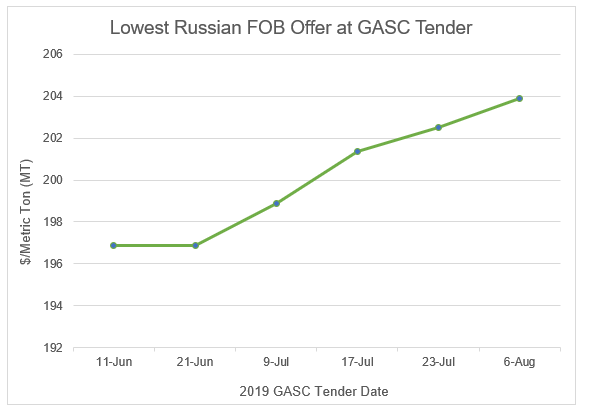Reduced Wheat Production Estimates Boost Russian Export Prices
By Claire Hutchins, USW Market Analyst
Extremely high temperatures and below-average precipitation levels prompted USDA to reduce its Russian wheat production forecast from 78.0 million metric tons (MMT) in its June World Agricultural Supply and Demand Estimates (WASDE) report to 74.2 MMT in its July WASDE report. That is a 5% reduction month over month. Russia’s leading agriculture consultancies also reduced their Russian wheat production forecasts. Between June 11 and July 24, SovEcon reduced its 2019/20 Russian wheat production forecast by 10% from 82.2 MMT to 73.7 MMT. Between early June 12 and August 5, IKAR reduced its Russian wheat production estimate by 6% from 80.2 MMT to 75.5 MMT.
All sources point to lower Russian wheat production, but SovEcon and IKAR differ in how they see reduced exportable supplies affecting Russian export prices. Despite reducing its wheat production forecast, SovEcon estimates “Russia’s wheat crop issues are not big enough to impress the market.” Accordingly, it quoted Russian FOB values for 12.5 protein wheat (equal to 11.0 protein on a 12% moisture basis) at $197/MT on July 29 and at $195/MT on August 2. IKAR, on the other hand, believes the country’s reduced exportable supplies contribute to rising FOB values. According to IKAR, Russian FOB values for 12.5 protein wheat rose from $193/MT on July 23 to $196/MT on July 30.
How should these price differentials be interpreted? A look at recent tenders from Egypt’s state commodity-procurement agency, the General Authority for Supply Commodities (GASC) provides some insight. Through GASC, Egypt publicly offers to purchase wheat in set amounts from global exporters. Grain trading companies source wheat from multiple origins to bid on the GASC tenders, vying to offer the lowest FOB prices available. The tender results are available to the public, offering a clear picture of current export prices by origin source.
Often, conditions affecting exportable supplies in the Black Sea are apparent in GASC tender results. For instance, between May and July 2018, USDA reduced its Russian wheat production forecast by 7% on abnormally wet conditions affecting spring wheat planting and abnormally dry conditions affecting winter wheat areas. In 2018, for example, Black Sea supply concerns made their way into GASC’s tender results. On June 12, 2018, Russia’s lowest offer at the GASC tender was $209/MT FOB. By August 2, 2018, Russia’s lowest offer reached $235/MT FOB as supply concerns worsened.
While Russian 2019/20 wheat production is expected to increase 3% over 2018/19 levels to 74.2 MMT, its exportable supplies (beginning stocks plus production minus domestic consumption) are expected to fall 2.0 MMT from last year to 49.0 MMT in 2019/20. This year’s weather challenges are again present in recent Egypt’s GASC tender results. Between June 11 and August 6, the lowest FOB offer Russian wheat increased 4% from $197/MT to $204/MT. It is worth noting that the August 2 U.S. Wheat Associates (USW) Price Report estimated Gulf FOB export price for U.S. hard red winter (HRW) with equivalent protein for September delivery at $205/MT.
U.S. Wheat Associates (USW) believes these price trends could continue if hot, dry conditions persist across Russia’s predominant wheat growing regions.
Every month, USW publishes a graphic summary of the latest data from USDA’s WASDE report, including global wheat market factors, major country and regional export history and U.S. wheat supply and demand summaries by class. View the monthly summary here.



